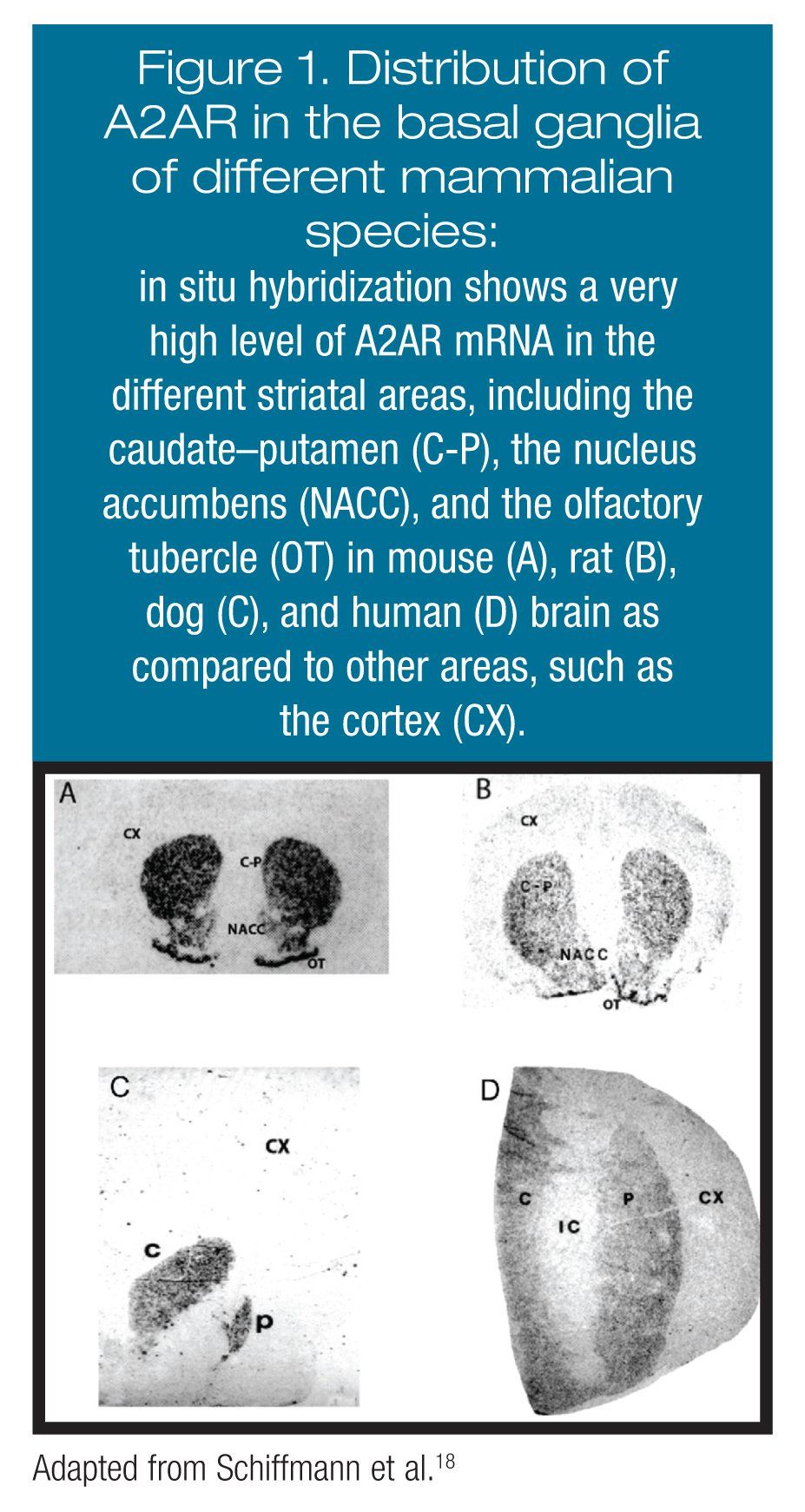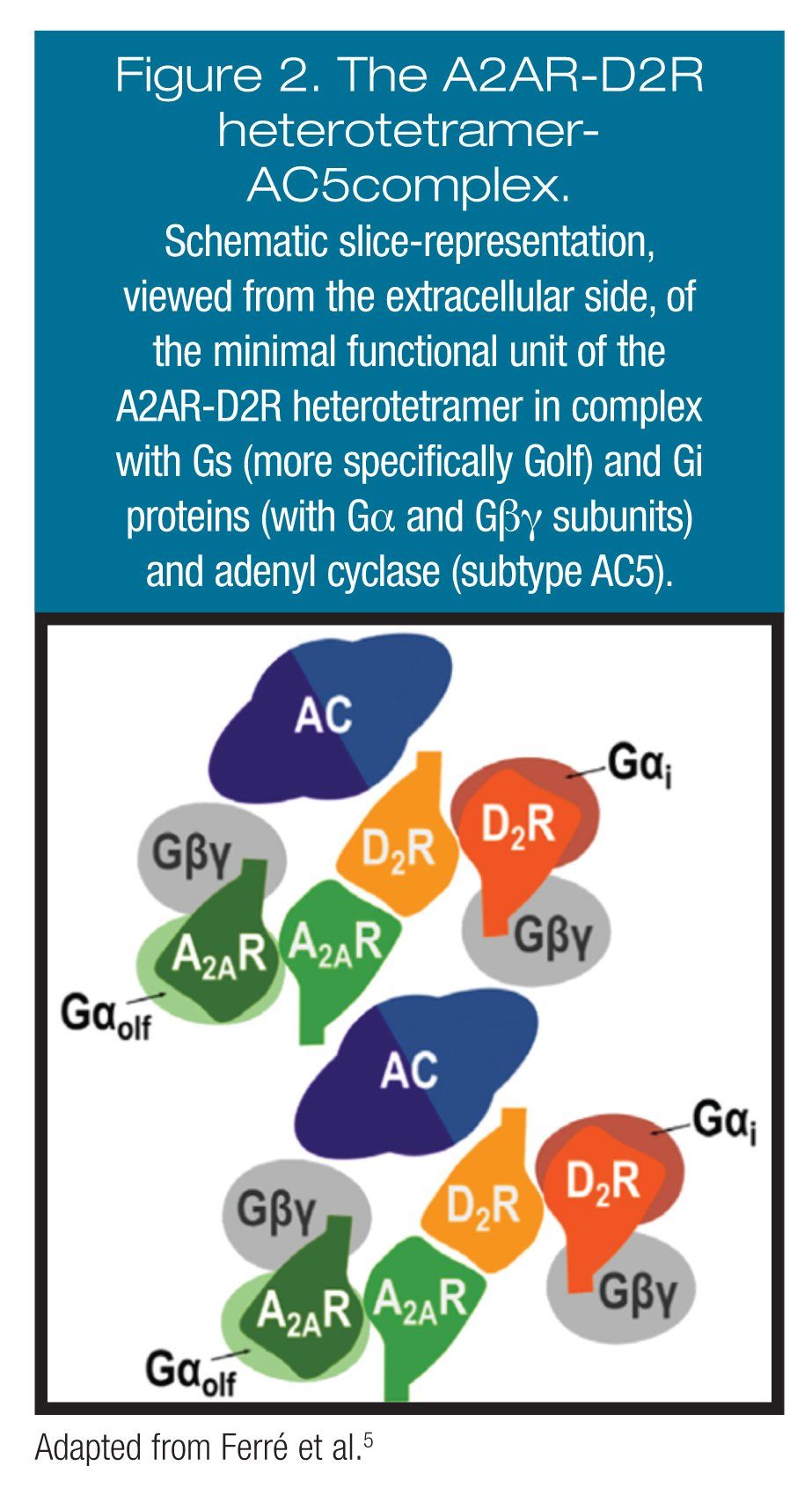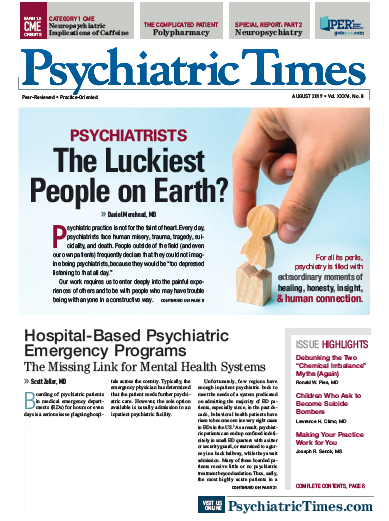Publication
Article
Psychiatric Times
Caffeine: Neurobiological and Psychiatric Implications
Author(s):
This CME article discusses the pharmacokinetics of caffeine and its implications on anxiety.
©SubbotinaAnna/Shutterstock.com

Figure 1. Distribution of A2AR in the basal ganglia of different mammalian species. Adapted from Schiffmann et al.[18]

Figure 2. The A2AR-D2R heterotetramer- AC5complex. Adapted from Ferré et al.[5]

Premiere Date: August 20, 2019
Expiration Date: February 20, 2021
This activity offers CE credits for:
1. Physicians (CME)
2. Other
All other clinicians either will receive a CME Attendance Certificate or may choose any of the types of CE credit being offered.
ACTIVITY GOAL
The goal of this activity is to provide an understanding of the mechanisms involved in the innervating effects of caffeine and the impact that caffeine may have on psychiatric disorders.
LEARNING OBJECTIVES
At the end of this CE activity, participants should be able to:
• Discuss the pharmacokinetics of caffeine
• Explain the adenosine-dependent modulation of striatal dopamine and glutamate neurotransmission
• Describe the adenosine-dependent modulation of glutamate neurotransmission in the amygdala
• Recount the implications of caffeine on anxiety
TARGET AUDIENCE
This continuing medical education activity is intended for psychiatrists, psychologists, primary care physicians, physician assistants, nurse practitioners, and other health care professionals who seek to improve their care for patients with mental health disorders.
CREDIT INFORMATION
CME Credit (Physicians): This activity has been planned and implemented in accordance with the Essential Areas and policies of the Accreditation Council for Continuing Medical Education (ACCME) through the joint providership of CME Outfitters, LLC, and Psychiatric Times. CME Outfitters, LLC, is accredited by the ACCME to provide continuing medical education for physicians.
CME Outfitters designates this enduring material for a maximum of 1.5 AMA PRA Category 1 Credit™. Physicians should claim only the credit commensurate with the extent of their participation in the activity.
Note to Nurse Practitioners and Physician Assistants: AANPCP and AAPA accept certificates of participation for educational activities certified for AMA PRA Category 1 Credit™.
DISCLOSURE DECLARATION
It is the policy of CME Outfitters, LLC, to ensure independence, balance, objectivity, and scientific rigor and integrity in all of their CME/CE activities. Faculty must disclose to the participants any relationships with commercial companies whose products or devices may be mentioned in faculty presentations, or with the commercial supporter of this CME/CE activity. CME Outfitters, LLC, has evaluated, identified, and attempted to resolve any potential conflicts of interest through a rigorous content validation procedure, use of evidence-based data/research, and a multidisciplinary peer-review process.
The following information is for participant information only. It is not assumed that these relationships will have a negative impact on the presentations.
Sergi Ferré, MD, PhD, has no disclosures to report.
Cyril Willson (peer/content reviewer), has no disclosures to report.
John J. Miller, MD (peer/content reviewer), has no disclosures to report.
Applicable Psychiatric Times staff and CME Outfitters staff have no disclosures to report.
UNLABELED USE DISCLOSURE
Faculty of this CME/CE activity may include discussion of products or devices that are not currently labeled for use by the FDA. The faculty have been informed of their responsibility to disclose to the audience if they will be discussing off-label or investigational uses (any uses not approved by the FDA) of products or devices. CME Outfitters, LLC, and the faculty do not endorse the use of any product outside of the FDA-labeled indications. Medical professionals should not utilize the procedures, products, or diagnosis techniques discussed during this activity without evaluation of their patient for contraindications or dangers of use.
For content-related questions, email us at PTEditor@mmhgroup.com; for questions concerning CME credit call us at 877.CME.PROS (877.263.7767)
Caffeine requires no introduction as it is the most commonly consumed psychotropic drug in the world. It is primarily used for its predictable psychostimulant properties on the CNS. As with many drugs found in nature, it naturally occurs in select plant species located in Africa, East Asia, and South America. For these plants, it serves as an insecticide and a fungicide. It is commonly found in the leaves, seeds, and/or nuts of coffee, tea, and cocoa plants.
Caffeine is a member of the molecular class methylated xanthines, which also includes theophylline, theobromine, and paraxanthine. All four molecules are remarkably similar in structure, and the non-caffeine members vary only in the placement of their two methyl groups (CH3). Caffeine uniquely has a third methyl group and is metabolized by the liver to varying percentages of the other three. All have psychostimulant properties but vary in other physiological effects. Theophylline also functions as a bronchodilator, and, not surprisingly, is used in the treatment of asthma and chronic obstructive pulmonary disease. Theobromine has significant diuretic properties in addition to its weak psychostimulant effects. Paraxanthine does not exist naturally in any plants but is the most common metabolite of caffeine in humans.
The coffee bean, which seems to have originated in Yemen, has only caffeine. It was first described around 1450, at which time Sufi monks used the coffee bean to make a beverage to help with wakefulness while praying in their monasteries in Yemen.1 Tea leaves contain primarily caffeine, but also have varying degrees of theophylline and theobromine. The use of tea as a beverage is described as far back as 3000 BCE, and tea leaves are found throughout East Asia.1 The cocoa bean contains primarily theobromine, with some caffeine and virtually no theophylline. Cocoa bean residue has been found in a Mayan pot dating back to 600 BCE.1
Historically, it has been challenging to elucidate the mechanism of action of caffeine as a CNS psychostimulant. Previous competing theories included: increase in calcium release; inhibition of the enzyme phosphodiesterase that results in an increase in the secondary messenger cAMP; and interaction with adenosine receptors. This third theory is now believed to be the primary mechanism by which caffeine acts as a psychostimulant.
Caffeine, which is similar in structure to adenosine, is a competitive antagonist of adenosine A1 and A2A receptors (A1R and A2AR). The psychostimulant effects of caffeine can be neurobiologically dissociated into psychomotor activation and increased arousal. Both pharmacological properties are responsible for the wide use of caffeine. The increased arousal is related to the caffeine-mediated counteraction of the effect of adenosine on homeostatic sleep. Caffeine counteracts the adenosine-mediated sleepiness induced by prolonged wakefulness, mostly by acting on A1R that control the activity of ascending arousal systems. On the other hand, caffeine produces psychomotor activation by acting preferentially on A2AR, by indirectly controlling striatal dopaminergic transmission.
Pharmacokinetics of caffeine
After drinking a beverage containing caffeine, it takes from 30 minutes to 2 hours to reach its maximum serum concentration on average. Because of its property of solubility in both lipids and water, it is rapidly distributed evenly in all tissues throughout the body. It readily crosses the blood-brain barrier, allowing rapid access to receptors in the brain.
There are a number of factors that can affect the metabolism of caffeine in humans, and hence its pharmacokinetics. The average half-life of caffeine in humans is 2 to 6 hours. Caffeine is metabolized by the liver in first pass metabolism through the cytochrome P450 1A2 enzyme (CYP450 1A2). In addition to being a substrate for CYP450 1A2, caffeine is also a moderate inhibitor of this enzyme.2,3
These properties have significant consequences for how the metabolism of caffeine is affected by some drugs, and how other drug metabolisms are affected by caffeine. The most common drug-drug interaction, which can have a clinical effect on how much caffeine is required to achieve a psychostimulant effect, is related to smoke. It is well established that smoke from any source (nicotine cigarettes or cigars, cannabis cigarettes, lengthy and prolonged exposure to smoke from a wood fire) induces the liver’s CYP450 1A2 enzyme-gradually increasing the activity of this enzyme by continuous smoke exposure over 2 weeks. This induction results in increased metabolism of caffeine by the CYP450 1A2 enzyme, requiring more caffeine to attain the same blood level as would be required in a non-smoker.1,2
Estradiol inhibits the metabolism of caffeine; hence taking estradiol on a regular basis requires less caffeine to achieve the same level as being off estradiol. During pregnancy-a high estrogen state-the half-life of caffeine can be increased up to 15 hours in the third trimester. The SSRI fluvoxamine, FDA approved to treat obsessive compulsive disorder, is a potent inhibitor of CYP450 1A2 and has been shown to increase caffeine’s half-life 10-fold.2,3
Moreover, caffeine can elevate blood levels of some medications that can have significant clinical effects. Through its activity as a moderate inhibitor at the CYP450 1A2 enzyme, caffeine can increase the serum levels of clozapine and warfarin. Patients who are taking clozapine can be challenging to maintain at a steady serum level, as smoking cigarettes will decrease clozapine levels and drinking caffeinated beverages will increase clozapine levels.2,3
Adenosine-dependent modulation of striatal dopamine and glutamate neurotransmission
Psychomotor activation is a major pharmacological effect of psychostimulants and classically implies a behavioral activation in response to specific stimuli, more specifically, to reward-related stimuli (rewards, conditioned rewards, or discriminative stimuli that signal the proximity of rewards). Psychostimulants also have reinforcing properties-the psychostimulant, itself, acts as a “reward” (ie, rewarding stimulus or reinforcer), implying that it elicits approach and work to obtain it.
These properties of psychostimulants are similar to those of dopamine in the brain and, particularly, in the striatum, the brain area with the highest dopamine innervation and the highest density of dopamine receptors. Thus, activation of the central dopamine system is involved with increasing responsiveness to reward-related stimuli-with orienting and approaching responses to those stimuli-thus reward-oriented behavior. Concomitantly, dopamine is directly involved with the learning (“stamping-in”) of stimulus-reward and reward-response associations that follows the receipt of reward.
Stimulus-reward associations lead some stimuli to acquire discriminative properties that signal the proximity of the reward or even to acquire rewarding properties (ie, conditioned rewarding stimuli), which become themselves behavioral attractors. The stamping-in of reward-response associations promotes positive reinforcement, the learning of the optimal sequential response-the action skill-that leads to the reward.
Dopamine cells increase their activity by the cues that predict the occurrence of the reward (discriminative/conditioned reward stimuli) and when the reward is better than expected (positive reward prediction error), in which case there is a phasic increase in striatal dopamine. This dopamine increase promotes activation of excitatory dopamine D1 receptors (D1R) and inhibitory dopamine D2 receptors (D2R), which have low and high affinity for dopamine, respectively. D1R and D2R are separately localized in the striatal cells that respectively constitute the “Go” (excitatory) and “No Go” (inhibitory) striatal efferent neuronal outputs.
The respective activation and inhibition promote the elicitation and learning of positively reinforced behaviors (approach behaviors). But dopamine cells also receive signals related to aversive stimuli and increase their activity with cues that predict the successful avoidance of an aversive stimulus. Consequently, there is elicitation and learning of negatively reinforced behaviors.
On the other hand, aversive stimuli (or cues that predict a non-avoidable aversive stimulus) produce inhibition of dopamine cell activity, which leads to the loss of a tonic activation of the high affinity D2R by endogenous dopamine. The consequent increase in the activity (by release of the D2R-mediated neuronal inhibition) of the “No Go” neuronal output, which is represented by the striatopallidal neurons, leads to freezing/withdrawal/escape behaviors.4,5
Classic psychostimulants, such as cocaine, methylphenidate, and amphetamine, activate the dopamine system by increasing the concentration of extracellular dopamine. In contrast, caffeine potentiates the effects of dopamine by counteracting adenosine neurotransmission. Blockade of A1R and A2AR in the striatum by caffeine releases the brake that endogenous adenosine exerts on dopamine activation, which is related to the ability of both adenosine receptors to establish molecular interactions and inhibitory modulations of dopamine receptors. Postsynaptic A2AR play the most significant role in the modulation of striatal dopamine neurotransmission.4,5
Apart from the high expression of D2R, the striatopallidal neuron expresses the highest density of A2AR in the brain (Figure 1). Experimental data indicate that striatal A2AR constitute the main target responsible for the psychomotor activating and rewarding effects of caffeine (for recent review, see Ferré4). Significantly, the predominant populations of both A2AR and D2R in the striatopallidal neuron establish strong functional and intermolecular interactions, forming A2AR-D2R heteromers (a receptor complex of, at least, two different receptors). With a significant lower density, A2AR are also localized presynaptically in corticostriatal glutamate terminals, where they form heteromers with A1R.4
Recent studies have provided details about the molecular structure and functional properties of A2AR-D2R and A1-A2A receptor heteromers. They constitute heterotetramers (with homodimers of A2AR and D2R or A2AR and A1R) that form part of large pre-coupled signaling complexes that include their cognate G proteins and the effector adenylyl cyclase (Figure 2).5-7 The A2AR-D2R heterotetramer acts as an integrative molecular device that allows reciprocal antagonistic interactions between adenosine and dopamine to facilitate a switch in the A2AR-mediated activation versus D2R-mediated inhibition of the striatopallidal neuron. In fact, A2AR activation is responsible for the increase in the activity of the striatopallidal neuron and the consequent freezing/withdrawal/escape behaviors induced by release of the D2R-mediated neuronal inhibition upon exposure to punishment-related stimuli. Caffeine or selective A2AR antagonists, on the other hand, block these effects and potentiate the effects of endogenous dopamine on D2R-mediated neuronal inhibition, promoting an apparent psychomotor activation as a result of inhibition of freezing/withdrawal/escape from punishment-related stimuli.4,5
The striatal A1R-A2AR receptor heteromer constitutes a molecular device to fine tune glutamate transmission. Low concentrations of adenosine activate A1R, which inhibits glutamate release, while higher concentrations also activate A2AR, which causes the opposite effect. Since there is a predominant tonic activation of presynaptic A1 versus A2AR, caffeine acts mostly as a presynaptic A1R antagonist and promotes a facilitation of striatal glutamate transmission, which locally promotes dopamine release from striatal dopamine terminals, therefore adding to the postsynaptic potentiation of dopamine transmission mediated by the A2AR-D2R heteromer in the striatopallidal neuron.4,7
Adenosine-dependent modulation of glutamate neurotransmission in the amygdala
The striatum is not the only localization of A1R and A2AR in the brain; adenosine also controls glutamate neurotransmission in other brain areas, such as the amygdala, by segregated presynaptic A1R and postsynaptic A2AR (expressed with significantly lower levels than in the striatum).8-10 The amygdala is the critical substrate of Pavlovian aversive conditioning, (ie, fear conditioning). The conditioned and unconditioned aversive stimuli converge in the lateral nucleus, where a variety of cellular events transform a neutral stimulus into an aversive conditioned stimulus.
The central nucleus of the amygdala is the major amygdalar output. For instance, its projections to the periaqueductal gray are involved in conditioned stimulus-induced freezing. Information from the lateral to the central nuclei is conveyed by the basal nucleus and the intercalated cell masses. The adenosine control of glutamate transmission onto the pyramidal neurons of the basal nucleus of the amygdala seems particularly critical. The A1R-mediated inhibition or an A2AR-mediated activation of the pyramidal cells of the basal nucleus leads to a respective decrease or increase in fear conditioning.8-10
The opposite effects of A1R and A2AR blockade have been documented experimentally, with A1R antagonists facilitating, while A2AR antagonists decrease fear conditioning.8-10 Therefore, adenosine-mediated modulation of glutamate transmission in the amygdala represents a potential mechanism for the documented effects of caffeine on anxiety.
Caffeine and implications for anxiety
Anxiety disorders are common in psychiatry, and anxiety is a common symptom in many other psychiatric disorders. It is generally known that low doses of caffeine can be anxiolytic and high doses can be anxiogenic, particularly in susceptible individuals. Several studies indicate that a common block of polymorphisms of the A2AR gene (grouped by linkage disequilibrium) that is associated with an increased expression of A2AR in the brain, predisposes to panic attacks and to the anxiogenic effects of caffeine.11-13 Based on the role of amygdalar A1R and A2AR on fear conditioning, A1R blockade, and not A2AR blockade, should lead to anxiogenic effects, making it difficult to explain the role of A2AR gene polymorphisms in anxiety and caffeine-induced anxiety. But the involvement of A2AR localized in the most posterior and medial part of the ventral striatum, with its putative role in fear extinction-the suppression of fear (more appropriately threat) conditioning-provides a possible way out of this conundrum.
Apart from the dopamine neurons that respond with a decrease in their activity upon presentation of an aversive and punishment-related stimulus, a specific population of dopamine cells increases its activity. In rodents, this neuronal subpopulation seems to be mostly localized in the most medial and posterior part of the ventral tegmental area (VTA), which specifically projects to the most posterior-medial part of the ventral striatum, the posterior-medial shell of the nucleus accumbens (NAc).14,15 This area of the striatum is mostly innervated by the rodent infralimbic cortex, equivalent to the rostral anterior cingulate cortex (ACC) in humans.
The infralimbic cortex innervates the interconnected posterior-medial portions of the VTA and shell of the NAc, the amygdala, and the insular cortex, and this circuit plays a key role in fear extinction. Specifically, the amygdalar input from the infralimbic cortex corresponds to the intercalated masses. These correspond to GABAergic inhibitory neurons also innervated by the pyramidal neurons of the basal nucleus and their activation leads to active inhibition of fear conditioned responses, to fear extinction. According to LeDoux and colleagues,16 active avoidance learning, with the elicitation of a behavioral response that avoids the interaction with the aversive stimulus, requires the suppression of fear conditioning. This system provides a significant additional mechanism by which dopamine promotes negative reinforcement during the establishment of an avoidance behavior-the switch “from fear to safety.”
Although still speculative, the anxiolytic effects of low doses of caffeine could be mostly mediated by blockade of striatal postsynaptic A2AR (in the A2AR-D2R heteromers) and presynaptic A1R (in the A1R-A2R heteromers) in the posterior-medial shell of the NAc, which should be expected to potentiate fear extinction. With higher doses of caffeine or with an increased expression of A2AR, as in the presence of anxiety susceptibility A2AR gene polymorphisms, striatal presynaptic A2AR blockade (in the A1R-A2AR heterodimer) would promote anxiety.
Conclusion
Caffeine is a naturally occurring psychotropic drug that has been used for its psychostimulant effects by humans for thousands of years. It is legal and requires no regulation, ubiquitous in most cultures, and used by all age groups. Although found naturally in coffee beans, tea leaves, and cocoa beans, it is added to many beverages that are consumed daily for its psychostimulant effects.
Caffeine is also used in a variety of over-the-counter medications to treat various symptoms, ranging from headaches to somnolence. Furthermore, caffeine has a wide array of other physiological effects that we continue to discover and characterize. There is now a solid body of research that supports caffeine’s mechanism of action as a psychostimulant resulting from it being a non-competitive antagonist on adenosine receptors, in part through their ability to interact with dopamine receptors.
However, much work remains to be done, particularly in relation to the psychiatric implications. Clinical studies are needed that specifically evaluate the role of caffeine and A2AR antagonists in persons with anxiety. In order to establish the therapeutic versus anxiogenic doses of caffeine, studies should control for the role of anxiety susceptibility of A2AR gene polymorphisms, as well as polymorphisms of the gene for CYP450 1A2, which determine significant individual pharmacokinetic differences of caffeine.
However, this would still provide an incomplete picture because of the large variety of exogenous and endogenous factors, such as age, sex, hormonal status, diet, smoking, and exposure to drugs that influence caffeine intake, absorption, metabolism and pharmacological effects. An additional complication is the recent discovery of the psychomotor effect of paraxanthine, the main metabolite of caffeine in humans, which is related to its additional specific ability to inhibit a cGMP-preferring phosphodiesterase.17
CME POST-TEST
Post-tests, credit request forms, and activity evaluations must be completed online at www.cmeoutfitters.com/PT (requires free account activation), and participants can print their certificate or statement of credit immediately (80% pass rate required). This Web site supports all browsers except Internet Explorer for Mac. For complete technical requirements and privacy policy, visit www.neurosciencecme.com/technical.asp.
PLEASE NOTE THAT THE POST-TEST IS AVAILABLE ONLY ON THE 20TH OF THE MONTH OF ACTIVITY ISSUE AND FOR 18 MONTHS AFTER.
Disclosures:
Dr Ferré is Senior Scientist and Chief of the Integrative Neurobiology Section, National Institute on Drug Abuse, Intramural Research Program, National Institutes of Health, Department of Health and Human Services, Baltimore, MD.
References:
1. Weinberg BA, Bealer BK. The World of Caffeine: The Science and Culture of the World’s Most Popular Drug. New York, London: Routledge; 2001.
2. Nehlig A. Interindividual differences in caffeine metabolism and factors driving caffeine consumption. Pharmacol Rev. 2018;70:384-411.
3. Cozza KL, Armstrong SC, Oesterheld JR. Concise Guide to Drug Interaction Principles for Medical Practice: Cytochrome P450s, IGTs, P-Glycoproteins, 2nd ed. Washington, DC; American Psychiatric Publishing; 2003.
4. Ferré S. Mechanisms of the psychostimulant effects of caffeine: implications for substance use disorders. Psychopharmacol. 2016;233:1963-1979.
5. Ferré S, Bonaventura J, Zhu W, et al. Essential control of the function of the striatopallidal neuron by pre-coupled complexes of adenosine A(2A)-dopamine D(2) receptor heterotetramers and adenylyl cyclase. Front Pharmacol. 2018;9:243.
6. Navarro G, Cordomà A, Casadó-Anguera V, et al. Evidence for functional pre-coupled complexes of receptor heteromers and adenylyl cyclase. Nat Commun. 2018;9:1242.
7. Navarro G, Cordomà A, Brugarolas M, et al. Cross-communication between G(i) and G(s) in a G-protein-coupled receptor heterotetramer guided by a receptor C-terminal domain. BMC Biol. 2018;16:24.
8. Rau AR, Ariwodola OJ, Weiner JL. Presynaptic adenosine A1 receptors modulate excitatory transmission in the rat basolateral amygdala. Neuropharmacol. 2014;77:465-74.
9. Rau AR, Ariwodola OJ, Weiner JL. Postsynaptic adenosine A2A receptors modulate intrinsic excitability of pyramidal cells in the rat basolateral amygdala. Int J Neuropsychopharmacol. 2015;18:1-13.
10. Simões AP, Machado NJ, Gonçalves N, et al. Adenosine A(2A) Receptors in the amygdala control synaptic plasticity and contextual fear memory. Neuropsychopharmacol. 2016;41:2862-2871.
11. Shinohara M, Saitoh M, Nishizawa D, et al. ADORA2A polymorphism predisposes children to encephalopathy with febrile status epilepticus. Neurology. 2013;80:1571-1576.
12. Hamilton SP, Slager SL, De Leon AB, et al. Evidence for genetic linkage between a polymorphism in the adenosine 2A receptor and panic disorder. Neuropsychopharmacol. 2004;29:558-565.
13. Childs E, Hohoff C, Deckert J, et al. Association between ADORA2A and DRD2 polymorphisms and caffeine-induced anxiety. Neuropsychopharmacol. 2008;33:2791-2800.
14. Quiroz C, Orrú M, Rea W, et al. Local control of extracellular dopamine levels in the medial nucleus accumbens by a glutamatergic projection from the infralimbic cortex. J Neurosci. 2016;36:851-859.
15. Lammel S, Lim BK, Ran C, et al. Input-specific control of reward and aversion in the ventral tegmental area. Nature. 2012;491:212-217.
16. LeDoux JE, Moscarello J, Sears R, et al. The birth, death and resurrection of avoidance: a reconceptualization of a troubled paradigm. Mol Psychiatry. 2017;22:24-36.
17. Orrú M, Guitart X, Karcz-Kubicha M, et al. Psychostimulant pharmacological profile of paraxanthine, the main metabolite of caffeine in humans. Neuropharmacol. 2013;67:476-484.
18. Schiffmann SN, Fisone G, Moresco R, et al. Adenosine A2A receptors and basal ganglia physiology. Prog Neurobiol. 2007;83:277-292. â







